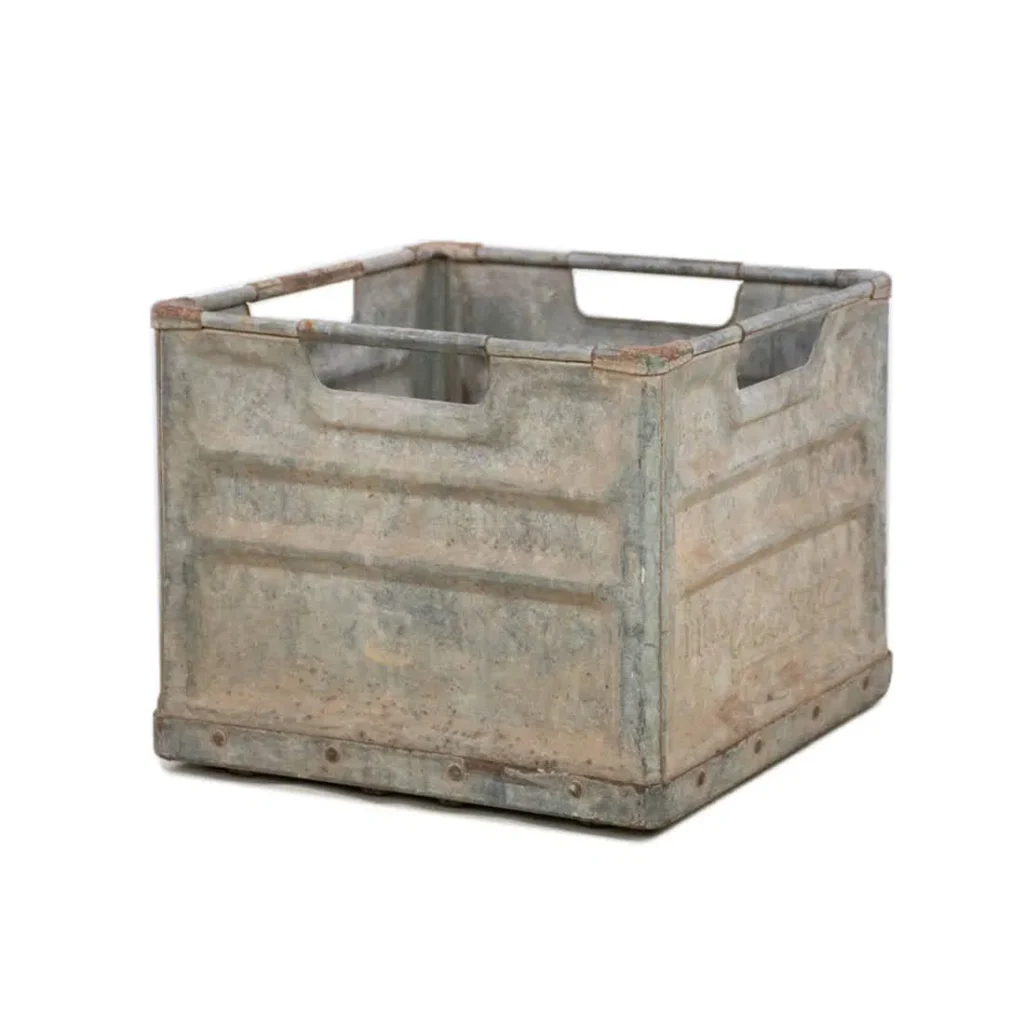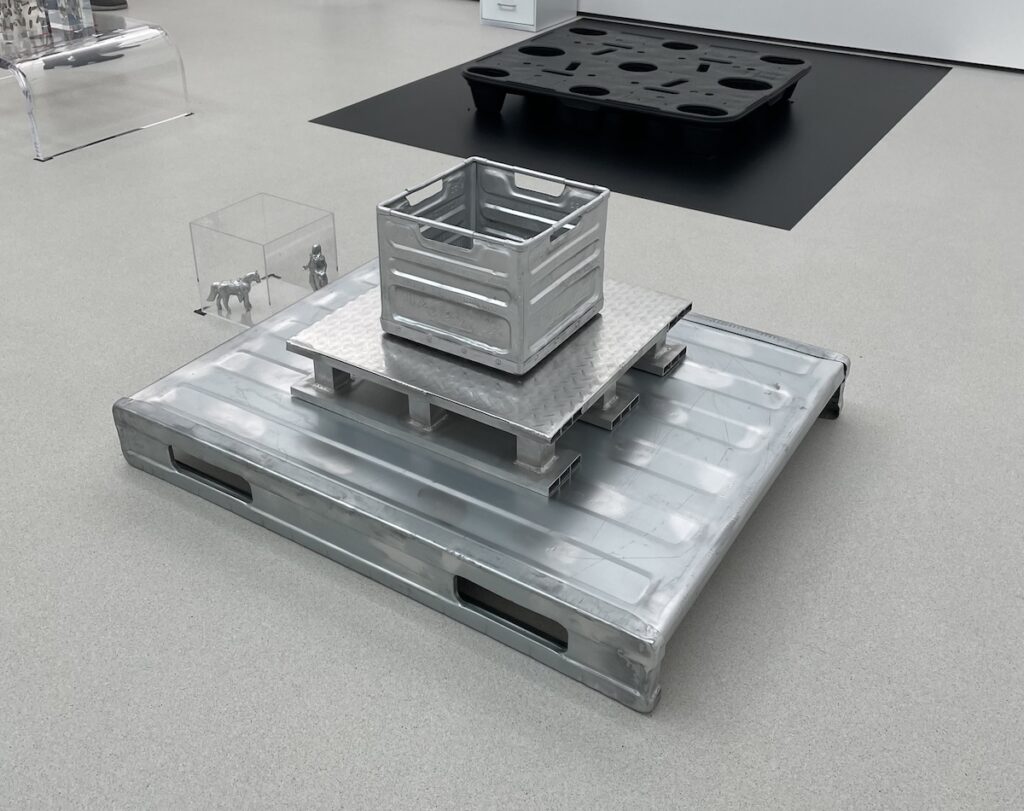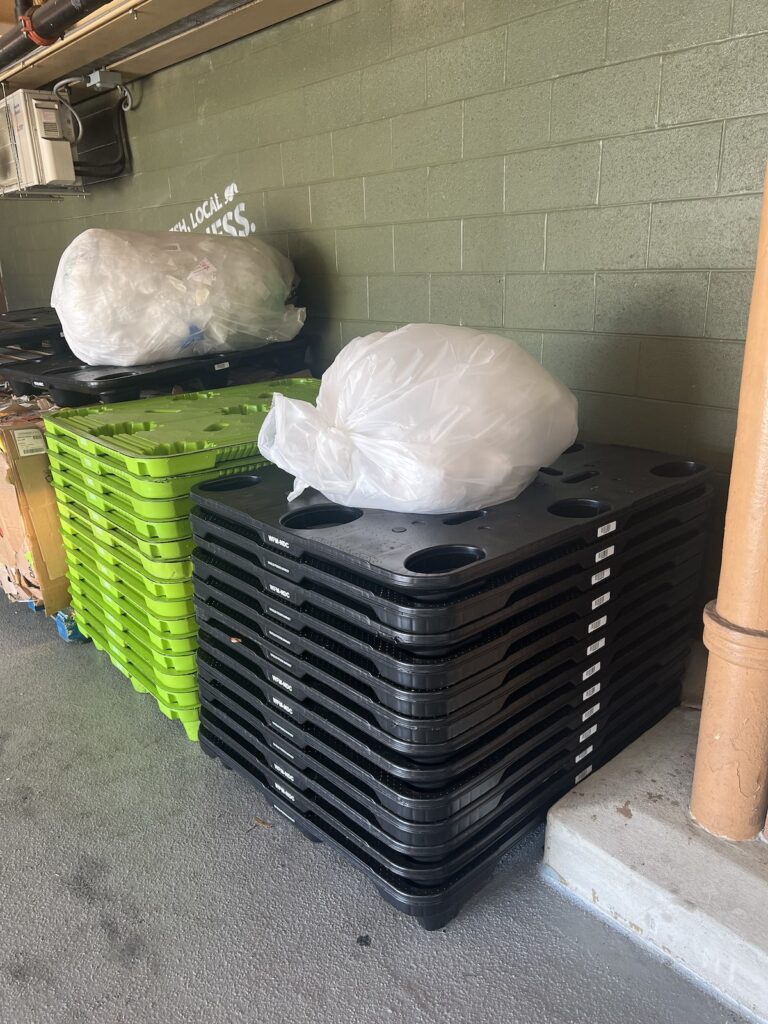Alex Greenberger not only has a review of Glenstone’s Cady Noland exhibition, he breaks news about it. And he not only breaks news about it, HE HAS PICTURES. Run, click, don’t walk. I’ll wait.
OK, while I think he’s kind of overinterpreted the transgressive unavailability of those black palettes Noland has added to the room otherwise filled by the contents of the artist’s Gagosian show last year, Greenberger is right to notice the slipperiness of the exhibition checklist. There are objects that are on the map, but not on the works list. The stacked palettes are an “element” in this category, and so is another stack of aluminum objects—which turns out to be a 2024 work “on loan” from the artist [scare quotes in the original].
It’s been almost three weeks, and they have not “corrected” their information, and the Glenstone folks get a little coy when Greenberger asks if they will. Now Glenstone is a professionally run and thoughtful institution where the impact of subtle detail is not unappreciated. This incompleteness, this inaccuracy, is part of the encounter; this disconnect between what you see and what you’re told is part of the experience.
[December 2024 update: they have added the loaned work to the checklist. It is “‘Untitled’ 2024, metal crate, metal palettes, courtesy the artist and Gagosian.”]
![clip-on man is a 1989 work by cady noland depicting a cropped photo of a wild drunk middle aged white guy in a dark suit with empty six pack rings clipped to his belt, a beer in his hand, and one left dangling in front of his crotch. the image is screenprinted in black on an aluminum panel, while a grid like a flimsy set of strainer bars sticks out on the right side, roughly forming a square. the work sits on a wood floor and leans against a white wall. the pic is via gagosian but the work is currently on loan from the artist [shhhh] to glenstone. the photo is by a guy named charles gatewood; he took it at mardi gras in the early 70s](https://greg.org/wp-content/uploads/2024/11/noland-clip-on-man-beachpkg-gagosian.jpg)
Let me add another piece of info in turn, which I don’t know whether to believe myself, but that fits: Clip-On Man, the 1989 work at the pavilions’ entrance, listed as being from a “private collection,” is also a loan from the artist.
In 2017, Beach Packaging Design blogged about Clip-On Man and the source of Noland’s deranged image: Sidetripping, a gonzo street photography book by Charles Gatewood, with a text hustled from William Burroughs, published in 1975 [hey, the same year as that Joan Didion speech!]
I read Sidetripping at Glenstone last time I was there, sitting on Martin Puryear’s elegant bench, facing a tastefully manicured wilderness. Gatewood revels in the underbelly of New Orleans as a degraded destination of American freakdom. Burroughs’ text is a highly baked, freeform riff on the photos, which Gatewood put in front of him while working on assignment for Rolling Stone. In subject, luridness, and bleakness, it felt like a touchstone for Noland’s entire project, if not a straight-up Rosetta Stone. I can see why she’d put that at the entrance of her show. [And name her previous show after it, and her book.]

[NEXT DAY UPDATE: I went back to Glenstone today to see this shiny stack I’d seen before, now disclosed to be a new work from the artist. This Pinkerton’s crate situation is a bit overdetermined, I think. There are actually two similar crates of stamped, galvanized sheet metal in the gallery, each with the name of a different regional dairy, and each threatening the involvement of the Pinkerton’s if you steal it. One looks like this, complete but very vintage. The one Alex says was cast certainly has a pristine finish. It could be sandblasted or remade, for sure. I did find a picture of the previously unacknowledged work on the internet:

That middle pallet is the one with the Amazon ASIN sticker still on it: the Vestil AP-ST-2424-SB, currently listed on AMZN as unavailable, though it can be easily found on other retail sites.
Speaking of Amazon and pallets, that black pallet in the background is of the type also mentioned in Alex’s review. It, too, is findable online, though maybe you need a commercial account to purchase it. I think the “violation of state law” thing is, like the Pinkerton’s warning, a boilerplate assertion of ownership for property that circulates unattended on these mean streets. A cattle brand for corporate assets.
On my way home, I had to return a cursed Amazon purchase, and so made a rare trip to a Whole Foods, where I was greeted by this:

While we wait to hear if these pallets, too, are a previously unacknowledged Cady Noland, we can bring their implication in the monopolistic retail/digital/content behemoth engulfing our world into the unsullied noncommercialism of the Glenstone installation. Also, if, looking back at the Gagosian show it felt like half the non-vintage elements were sourced at The Container Store, remember there is one in Chelsea, right next to a huge Whole Foods. Instead of an artist who has walked away from artmaking, we may have to reimagine Noland as someone making art from the churning world she passes through every day on her way to the gym.
